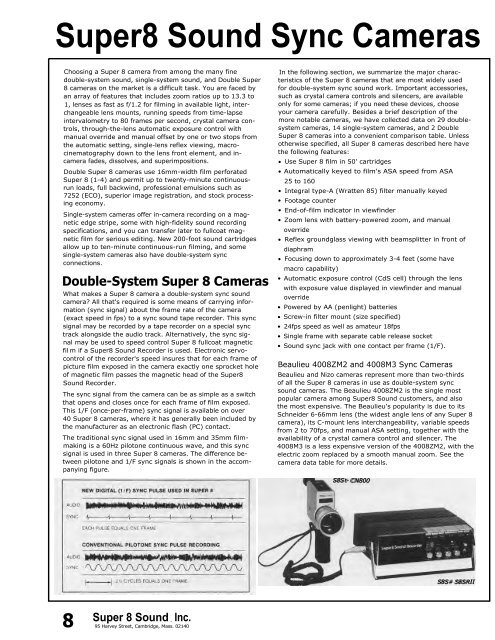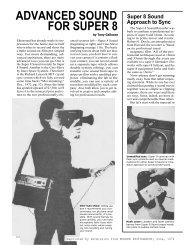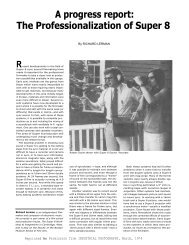Super 8 Sound Inc. - Desktop Video Group
Super 8 Sound Inc. - Desktop Video Group
Super 8 Sound Inc. - Desktop Video Group
You also want an ePaper? Increase the reach of your titles
YUMPU automatically turns print PDFs into web optimized ePapers that Google loves.
<strong>Super</strong>8 <strong>Sound</strong> Sync Cameras<br />
Choosing a <strong>Super</strong> 8 camera from among the many fine<br />
double-system sound, single-system sound, and Double <strong>Super</strong><br />
8 cameras on the market is a difficult task. You are faced by<br />
an array of features that includes zoom ratios up to 13.3 to<br />
1, lenses as fast as f/1.2 for filming in available light, interchangeable<br />
lens mounts, running speeds from time-lapse<br />
intervalometry to 80 frames per second, crystal camera controls,<br />
through-the-lens automatic exposure control with<br />
manual override and manual offset by one or two stops from<br />
the automatic setting, single-lens reflex viewing, macrocinematography<br />
down to the lens front element, and incamera<br />
fades, dissolves, and superimpositions.<br />
Double <strong>Super</strong> 8 cameras use 16mm-width film perforated<br />
<strong>Super</strong> 8 (1-4) and permit up to twenty-minute continuousrun<br />
loads, full backwind, professional emulsions such as<br />
7252 (ECO), superior image registration, and stock processing<br />
economy.<br />
Single-system cameras offer in-camera recording on a magnetic<br />
edge stripe, some with high-fidelity sound recording<br />
specifications, and you can transfer later to fullcoat magnetic<br />
film for serious editing. New 200-foot sound cartridges<br />
allow up to ten-minute continuous-run filming, and some<br />
single-system cameras also have double-system sync<br />
connections.<br />
Double-System <strong>Super</strong> 8 Cameras<br />
What makes a <strong>Super</strong> 8 camera a double-system sync sound<br />
camera? All that's required is some means of carrying information<br />
(sync signal) about the frame rate of the camera<br />
(exact speed in fps) to a sync sound tape recorder. This sync<br />
signal may be recorded by a tape recorder on a special sync<br />
track alongside the audio track. Alternatively, the sync signal<br />
may be used to speed control <strong>Super</strong> 8 fullcoat magnetic<br />
fil m if a <strong>Super</strong>8 <strong>Sound</strong> Recorder is used. Electronic servocontrol<br />
of the recorder's speed insures that for each frame of<br />
picture film exposed in the camera exactly one sprocket hole<br />
of magnetic film passes the magnetic head of the <strong>Super</strong>8<br />
<strong>Sound</strong> Recorder.<br />
The sync signal from the camera can be as simple as a switch<br />
that opens and closes once for each frame of film exposed.<br />
This 1/F (once-per-frame) sync signal is available on over<br />
40 <strong>Super</strong> 8 cameras, where it has generally been included by<br />
the manufacturer as an electronic flash (PC) contact.<br />
The traditional sync signal used in 16mm and 35mm filmmaking<br />
is a 60Hz pilotone continuous wave, and this sync<br />
signal is used in three <strong>Super</strong> 8 cameras. The difference between<br />
pilotone and 1/F sync signals is shown in the accompanying<br />
figure.<br />
8<br />
<strong>Super</strong> 8 <strong>Sound</strong> , <strong>Inc</strong>.<br />
95 Harvey Street, Cambridge, Mass. 02140<br />
In the following section, we summarize the major characteristics<br />
of the <strong>Super</strong> 8 cameras that are most widely used<br />
for double-system sync sound work. Important accessories,<br />
such as crystal camera controls and silencers, are available<br />
only for some cameras; if you need these devices, choose<br />
your camera carefully. Besides a brief description of the<br />
more notable cameras, we have collected data on 29 doublesystem<br />
cameras, 14 single-system cameras, and 2 Double<br />
<strong>Super</strong> 8 cameras into a convenient comparison table. Unless<br />
otherwise specified, all <strong>Super</strong> 8 cameras described here have<br />
the following features:<br />
• Use <strong>Super</strong> 8 film in 50' cartridges<br />
• Automatically keyed to film's ASA speed from ASA<br />
25 to 160<br />
• Integral type-A (Wratten 85) filter manually keyed<br />
• Footage counter<br />
• End-of-film indicator in viewfinder<br />
• Zoom lens with battery-powered zoom, and manual<br />
override<br />
• Reflex groundglass viewing with beamsplitter in front of<br />
diaphram<br />
• Focusing down to approximately 3-4 feet (some have<br />
macro capability)<br />
• Automatic exposure control (CdS cell) through the lens<br />
with exposure value displayed in viewfinder and manual<br />
override<br />
• Powered by AA (penlight) batteries<br />
• Screw-in filter mount (size specified)<br />
• 24fps speed as well as amateur 18fps<br />
• Single frame with separate cable release socket<br />
• <strong>Sound</strong> sync jack with one contact per frame (1/F).<br />
Beaulieu 4008ZM2 and 4008M3 Sync Cameras<br />
Beaulieu and Nizo cameras represent more than two-thirds<br />
of all the <strong>Super</strong> 8 cameras in use as double-system sync<br />
sound cameras. The Beaulieu 4008ZM2 is the single most<br />
popular camera among <strong>Super</strong>8 <strong>Sound</strong> customers, and also<br />
the most expensive. The Beaulieu's popularity is due to its<br />
Schneider 6-66mm lens (the widest angle lens of any <strong>Super</strong> 8<br />
camera), its C-mount lens interchangeability, variable speeds<br />
from 2 to 70fps, and manual ASA setting, together with the<br />
availability of a crystal camera control and silencer. The<br />
4008M3 is a less expensive version of the 4008ZM2, with the<br />
electric zoom replaced by a smooth manual zoom. See the<br />
camera data table for more details.<br />
S8St- CN800<br />
S8S# S8SRII








